
Hiking Around Las Vegas, Red Rocks National Conservation Area, Mt Potosi Area

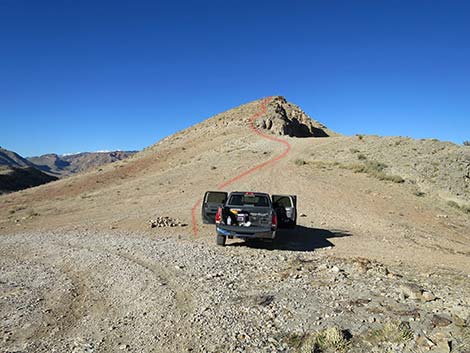 Birdspring Peak trailhead (view N) |
Overview The Birdspring Range runs north-south along the eastern flank of Mt. Potosi and forms a small part of the southwestern margin of the Las Vegas Valley. Birdspring Peak is little more than a hill compared to the nearby mountains, but the 1.5-mile round-trip hike to this peak overlooking Red Rock Canyon NCA and the Las Vegas Valley makes for a very pleasant, easy, off-trail adventure in a scenic place. Views from the summit are surprisingly grand for such a low peak. While the view west is blocked by nearby Mt. Potosi, views northeast stretch into Utah, views east extend over northern Arizona, and views south reach into California. The west side of the ridge burned in the Goodsprings Fire (2005) and again in the Cottonwood Fire (2020), and it is interesting to see patches of desert scrub that escaped the fires and how they are recovering. Beneath the shrubs, the bedrock is full of interesting fossil shells, corals, and sponges. Link to map. |
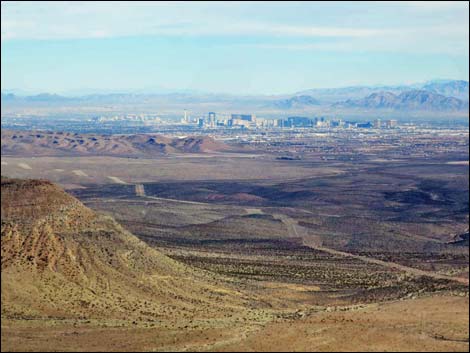 Las Vegas (view NE from the saddle) |
Watch Out Other than the standard warnings about hiking in the desert, ...much of the easiest hiking is right along the crest of the ridge where the slope to the west is moderately steep and the slope to the east is near-vertical for hundreds of feet. This probably isn't a good hike for young children or dogs. Cottonwood Valley is a popular area for mountain bikers, so watch for bicycles careening down the road. While hiking, please respect the land and the other people out there, and try to Leave No Trace of your passage. Also, even though this is a short hike, the area is remote, so be sure to bring the 10 Essentials. |
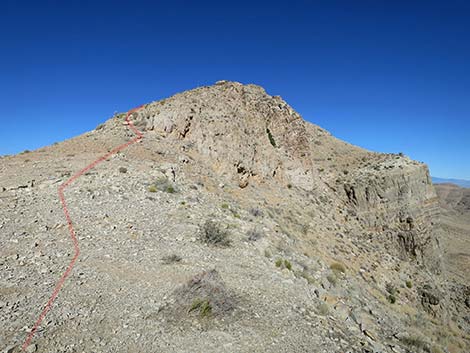 The route runs up the ridgeline (view N) |
Getting to the Trailhead This hike is located about 1 hour southwest of town on the edge of the Las Vegas valley along the base of Mt. Potosi between Blue Diamond and Goodsprings, and inside Red Rock Canyon National Conservation Area. From Las Vegas, drive south on I-15 then west on Highway 160 (Pahrump Highway) to the Cottonwood Valley Trailhead, which is about 200 yards down the Cottonwood Valley Road. Continue south on Cottonwood Valley Road for 3.2 miles to Cottonwood Pass. Getting onto the pass almost always requires a 4WD vehicle. From Cottonwood Pass, continue south on Cottonwood Valley Road for 0.3 miles to the intersection with Birdspring Road. Turn left onto Birdspring Road and drive east to the saddle on the crest of the mountain range (not the very end of the road). Park here; this is the trailhead. |
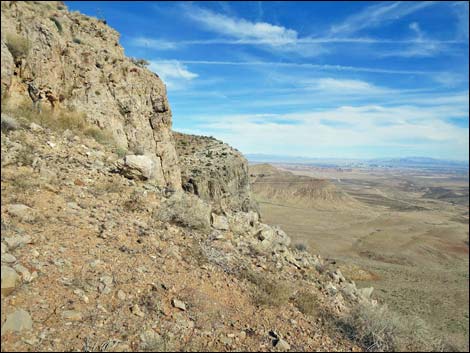 Looking over the east edge (view NE) |
The Hike From the trailhead (Table 1, Waypoint 01), consider walking 1-2 minutes out of the way to Birdspring Overlook at the very end of the old road. The view is somewhat better than than view from the trailhead parking saddle. From the saddle (Wpt. 01), the route turns north and follows faint and intermittent game trails up the crest of the ridge. There is a faint trail that switchbacks up the west side of the ridge, but I think I prefer just heading up the ridgeline. The first five minutes or so of hiking are the steepest of the entire route. After the route crests out on the first little peaklet (Wpt. 02), the rest of the journey is a pleasant walk on the fairly level summit ridge. The route runs north along the crest of the ridge, climbing over little summits and dropping through each little saddle. The elevation changes are slight, and the grades are gentle. Eventually, the route passes a little peaklet with a large cairn (Wpt 03). It would seem that this is the summit, but alas, it is a false summit. |
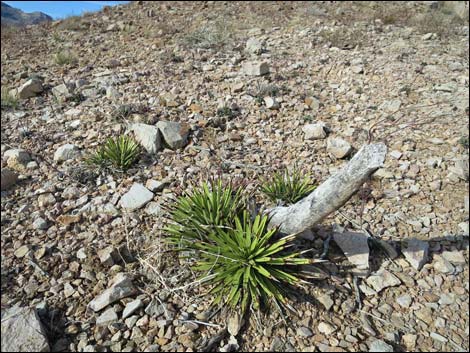 Joshua Tree sprouting from the burned stump after the fire |
Continuing north, the route runs over more false summits before eventually climbing onto the True Summit (Birdspring Peak; Wpt. 04). As far as summits go, this might be a disappointment, but the point of the hike is a nice stroll in the desert, so this peak works just fine. There is a summit cairn, but no register, and the summit is marked with a big buckhorn cholla that can be seen from some distance on account of the fire clearing off most other vegetation. Views from the summit (Wpt. 04) are surprisingly grand for such a low peak. To the north, views include the Red Rock Escarpment and the La Madre Range, and behind them, the summits of Mt. Charleston and Mummy Mountain. Turning eastward, the Sheep Range, Las Vegas Range, Muddy Mountains, Mormon Mountains, and the mountains above St. George, UT, can be seen. To the east, the Virgin Mountains, Grand Wash Cliffs, and many mountain ranges across northern Arizona are visible, including (I think) Hualapai Peak beyond Kingman, AZ. To the south, the North and South McCullough Mountains, the New York Mountains, and the Clark Range can be seen to the south. To the west, the view is blocked by Mt. Potosi, but oh what a view of Potosi and the Carol Lombard Crash Site! |
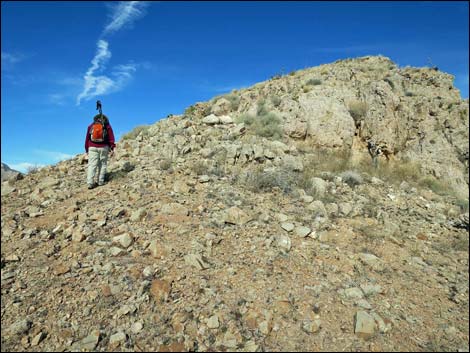 Hiker starting up the rocky ridgeline (view N) |
Looking north from the true summit, a broad, rounded peak looks as if it might be higher; it is not. However, despite the grand views from the true summit, hikers might enjoy a bit more hiking along the ridgeline to Peak 5,298 (Wpt. 05). Regardless of where hikers turn back, pick your peak and relax, eat lunch, take a few photos, and then walk back south along the ridgeline to the trailhead (Wpt. 01). For hikers who didn't see bighorn sheep on the way up, keep a closer eye on the way down. Everything looks different on the way down, and photos of the descent are presented here. |
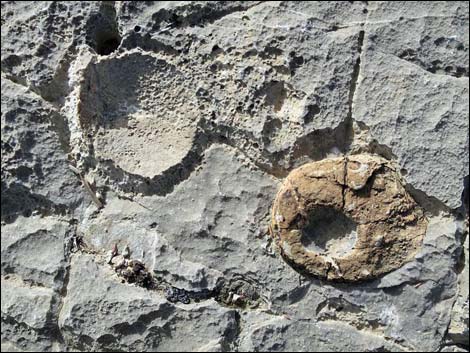 Fossils in the limestone |
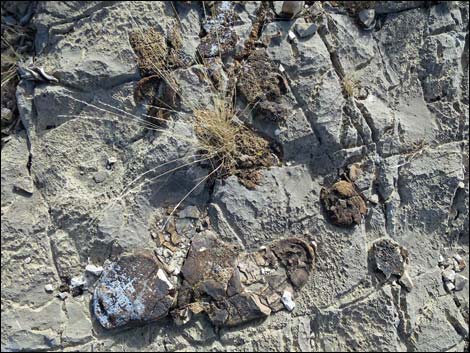 More fossils in the limestone |
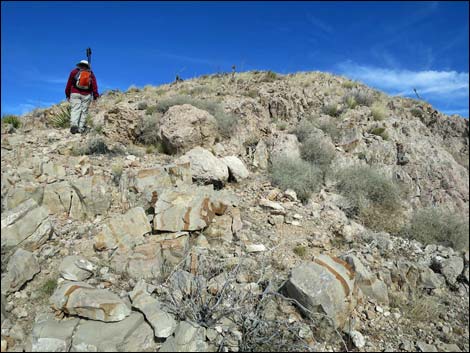 Hiker on the ridgeline (view N) |
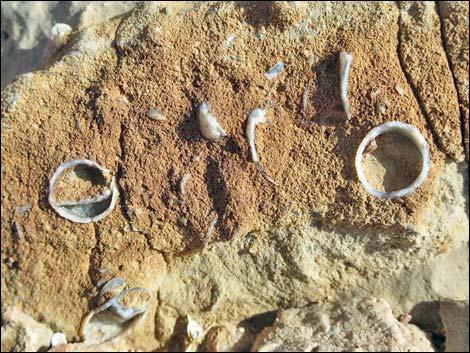 Fossils on the ridge |
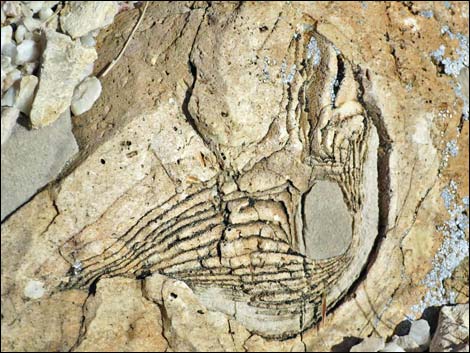 Fossils on the ridge |
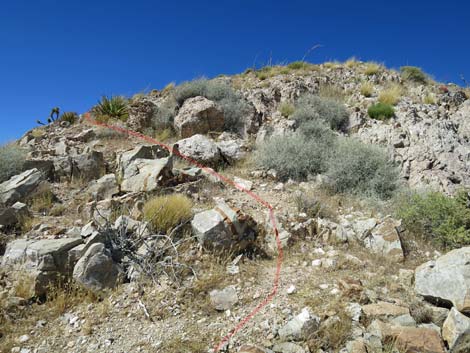 The steepest part of the route (view N) |
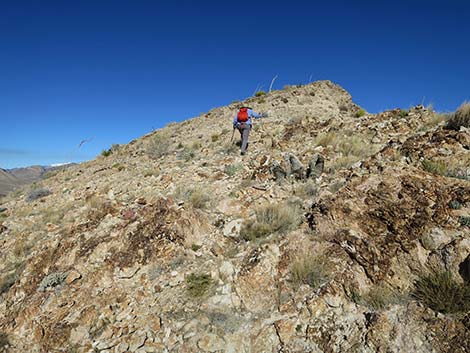 Birdspring Peak Trailhead (view E from the saddle) |
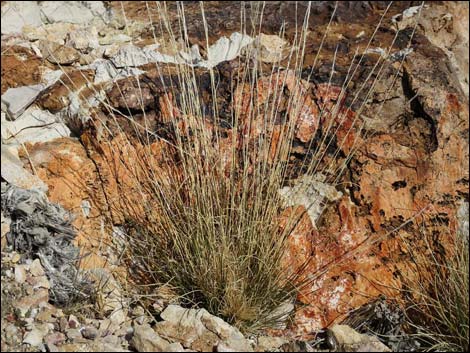 Bunch grass and interesting red mineral deposit |
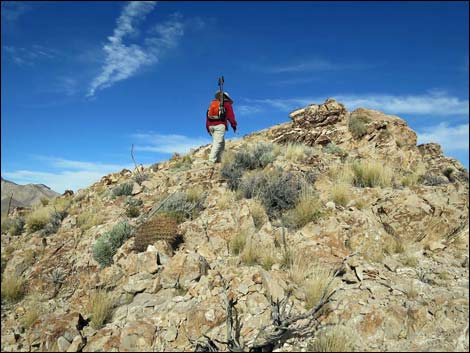 Hiker nearing the first peaklet on the ridgeline (view N) |
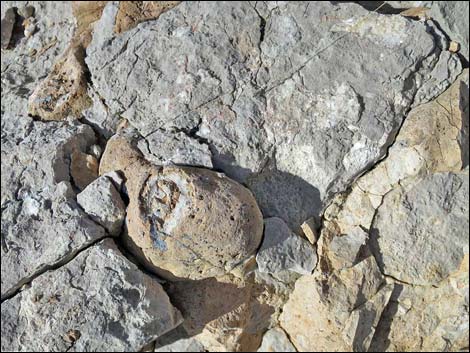 Fossils on the ridge |
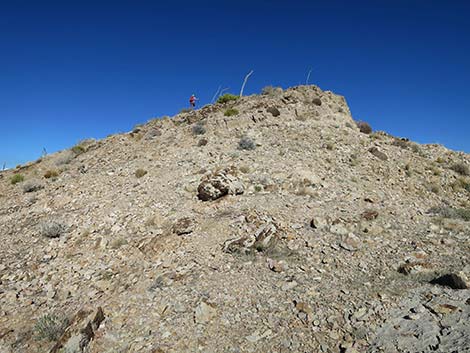 Route follows the ridgeline (view N) |
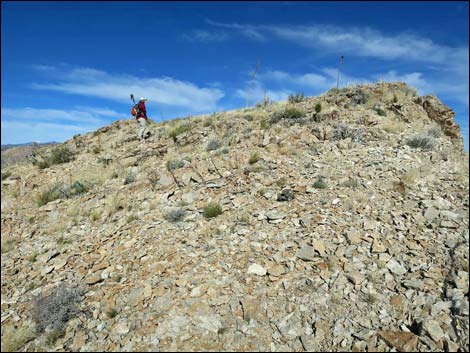 Hiker approaching the first peaklet on the ridgeline (view N) |
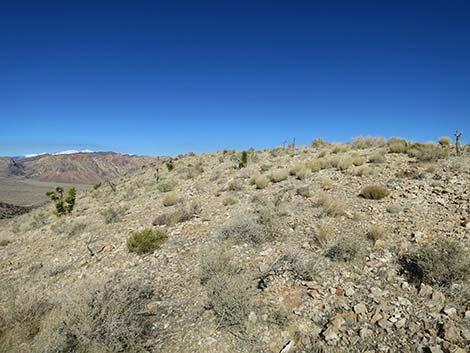 Arriving on the first peaklet on the ridgeline (view N) |
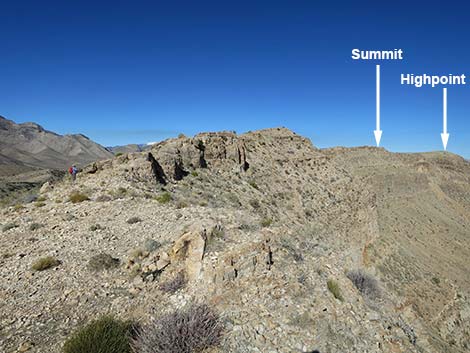 First grand view up the ridgeline (view N) |
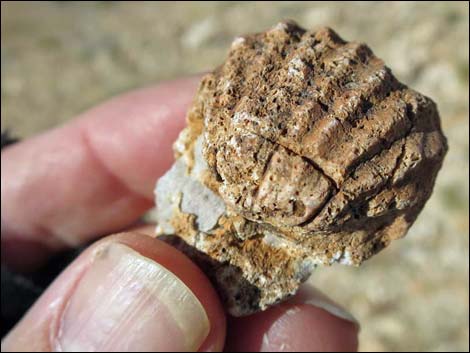 Fossils on the ridge |
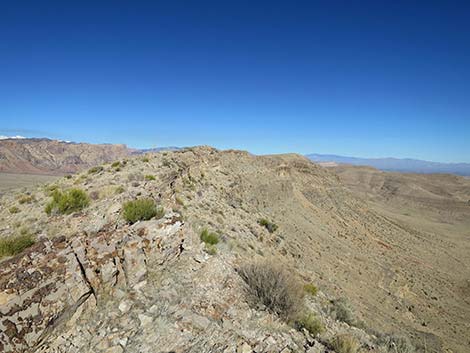 Route follows the ridgeline (view N) |
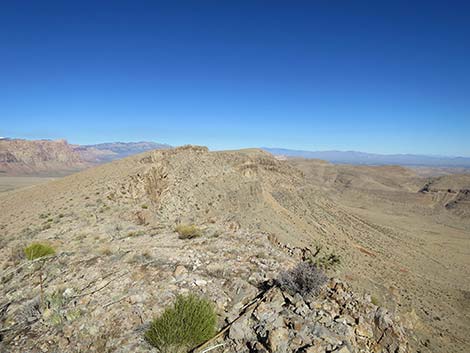 Route follows the ridgeline (view N) |
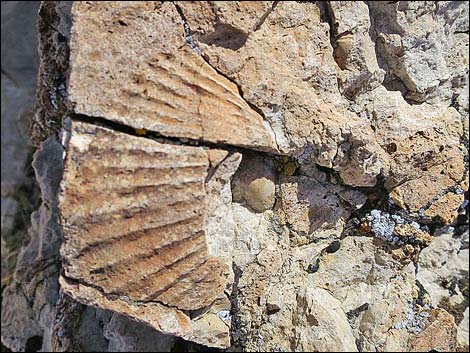 Fossils on the ridge |
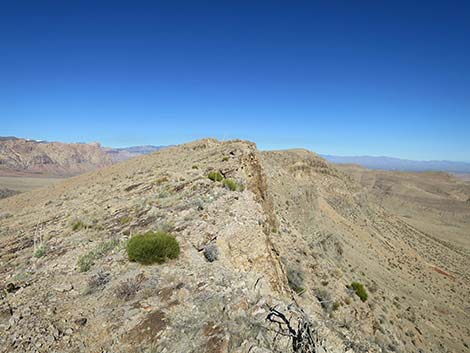 Route follows the ridgeline (view N) |
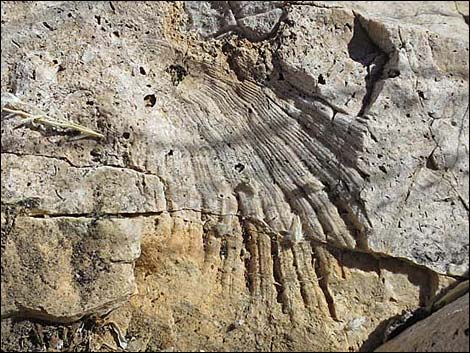 Fossils on the ridge |
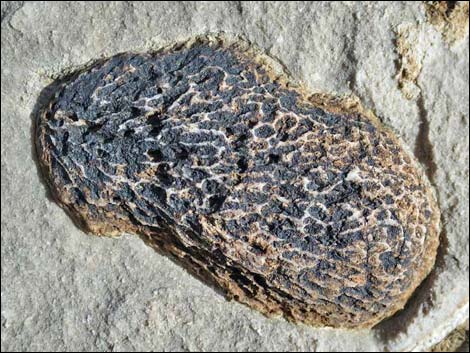 Fossils on the ridge |
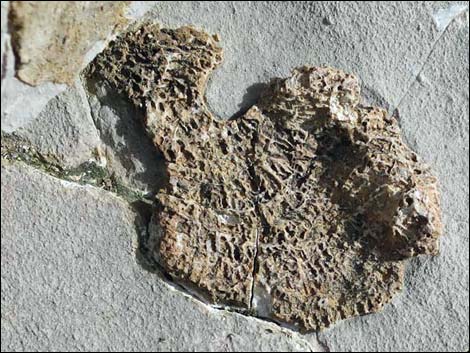 Fossils on the ridge |
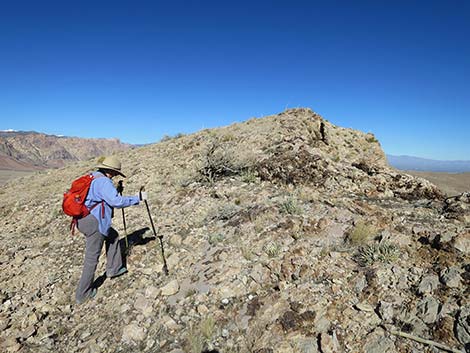 Route follows the ridgeline (view N) |
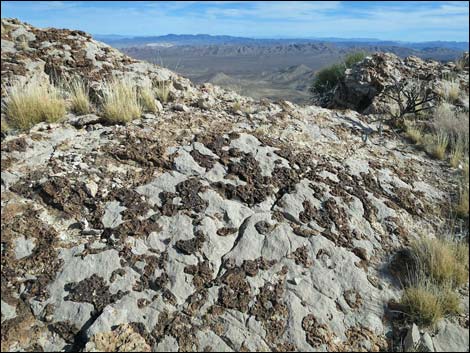 Fossils on the ridge |
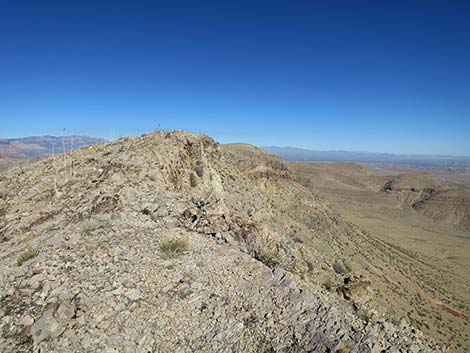 Route follows the ridgeline (view N) |
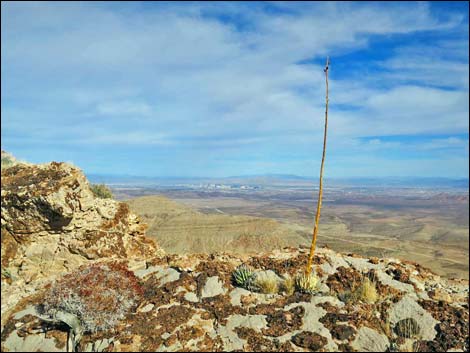 Fossils and Utah Agave on the ridge |
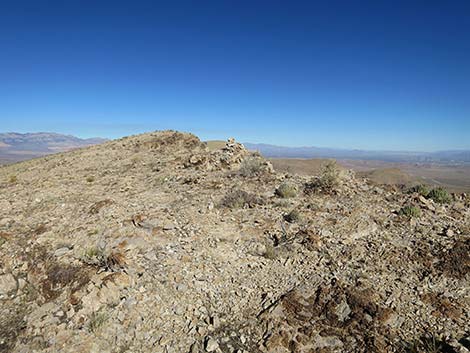 Approaching the false summit (view N) |
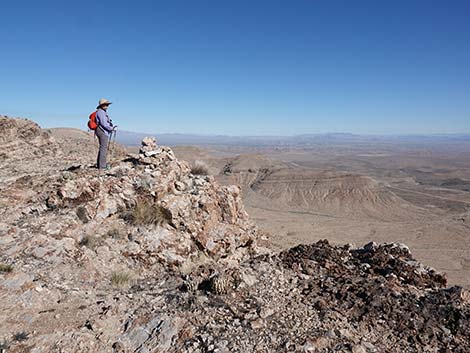 Hiker at the false summit (view NE) [additional summit view photos] |
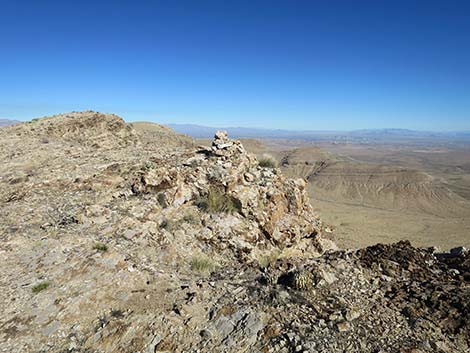 Cairn on false summit (view NE) |
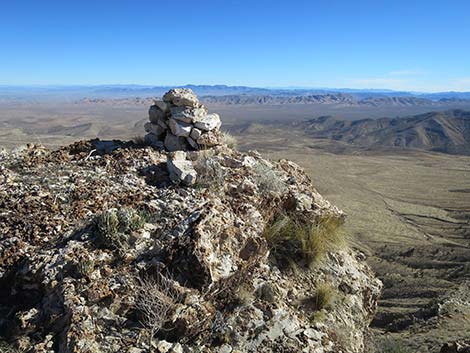 False summit cairn (view NE) |
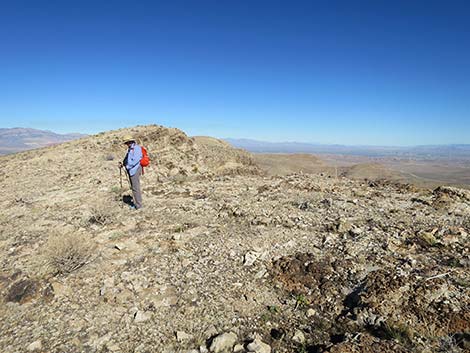 Hiker continuing north along the ridge (view NE) |
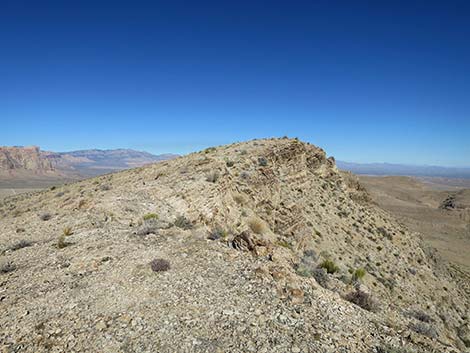 Route follows the ridgeline (view N) |
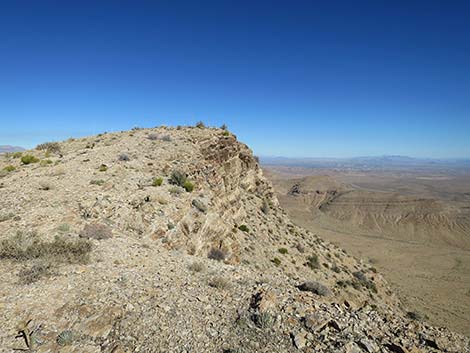 Approaching the true summit (view NE)? |
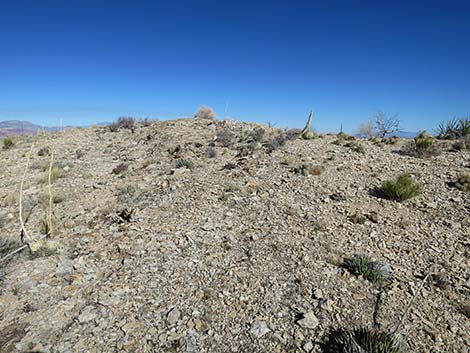 Approaching the true summit (view NE)? |
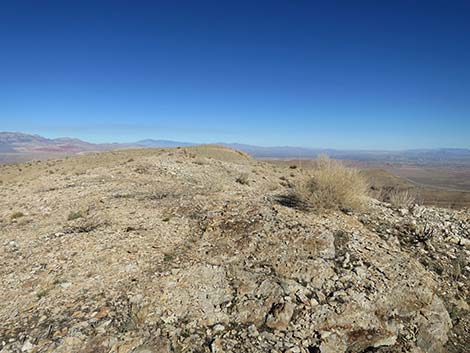 Nope, another false summit (view NE) |
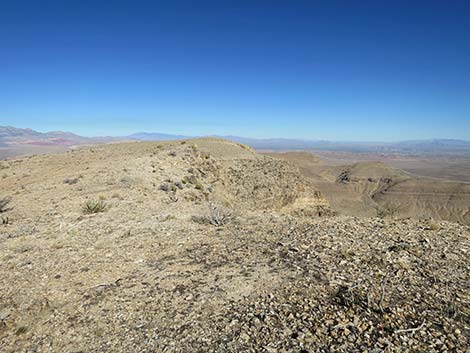 Route follows the ridgeline (view N) |
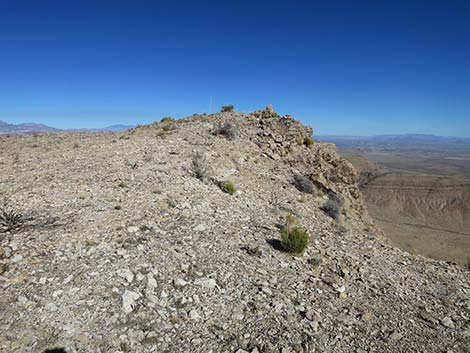 Approaching the true summit (view N) |
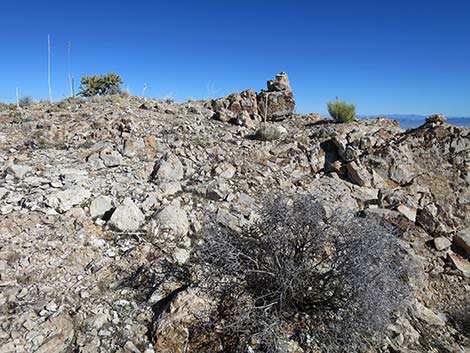 Arriving at the true summit (view NE) |
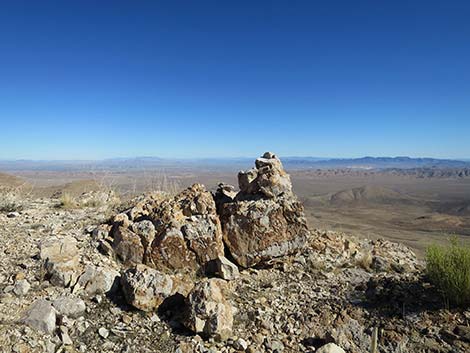 True summit (view NE) [additional summit view photos] |
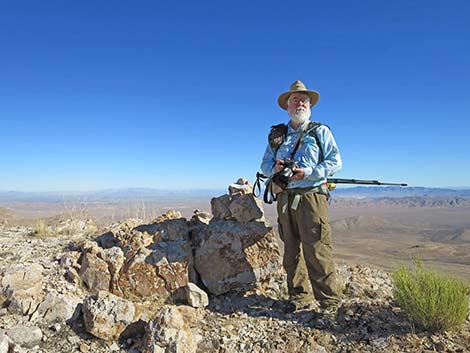 Hiker on the true summit (view NE) [additional summit view photos] |
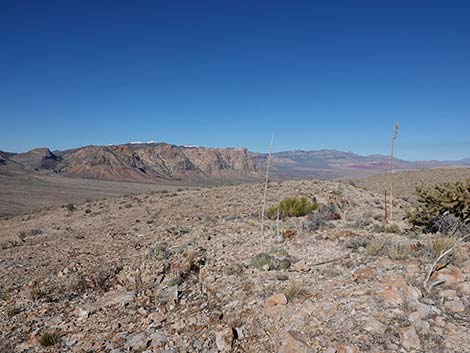 Summit (grand view of the Red Rock Cliffs (view NNW) |
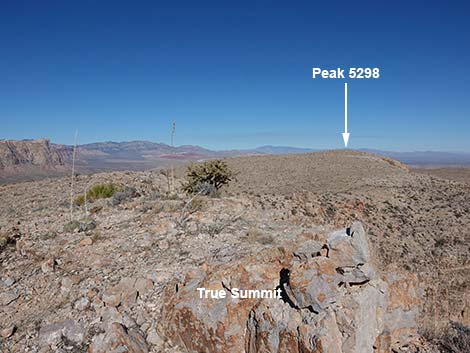 Hikers might consider continuing to Peak 5298 (view N) |
Table 1. Hiking Coordinates and Distances based on GPS Data (NAD27; UTM Zone 11S). Download Hiking GPS Waypoints (*.gpx) file.
| Wpt. | Location | UTM Easting | UTM Northing | Elevation (ft) | Point-to-Point Distance (mi) | Cumulative Distance (mi) |
|---|---|---|---|---|---|---|
| 01 | Trailhead | 641748 | 3980101 | 5,027 | 0.00 | 0.00 |
| 02 | First Peaklet | 641721 | 3980300 | 5,188 | 0.15 | 0.15 |
| 03 | False Summit | 641607 | 3980947 | 5,269 | 0.44 | 0.59 |
| 04 | True Summit | 641660 | 3981191 | 5,291 | 0.17 | 0.76 |
| 05 | Peak 5298 | 641804 | 3981532 | 5,306 | 0.25 | 1.01 |
| 01 | Trailhead | 641748 | 3980101 | 5,027 | 1.01 | 2.02 |
Happy Hiking! All distances, elevations, and other facts are approximate.
![]() ; Last updated 240329
; Last updated 240329
| Hiking Around Red Rocks | Hiking Around Las Vegas | Glossary | Copyright, Conditions, Disclaimer | Home |